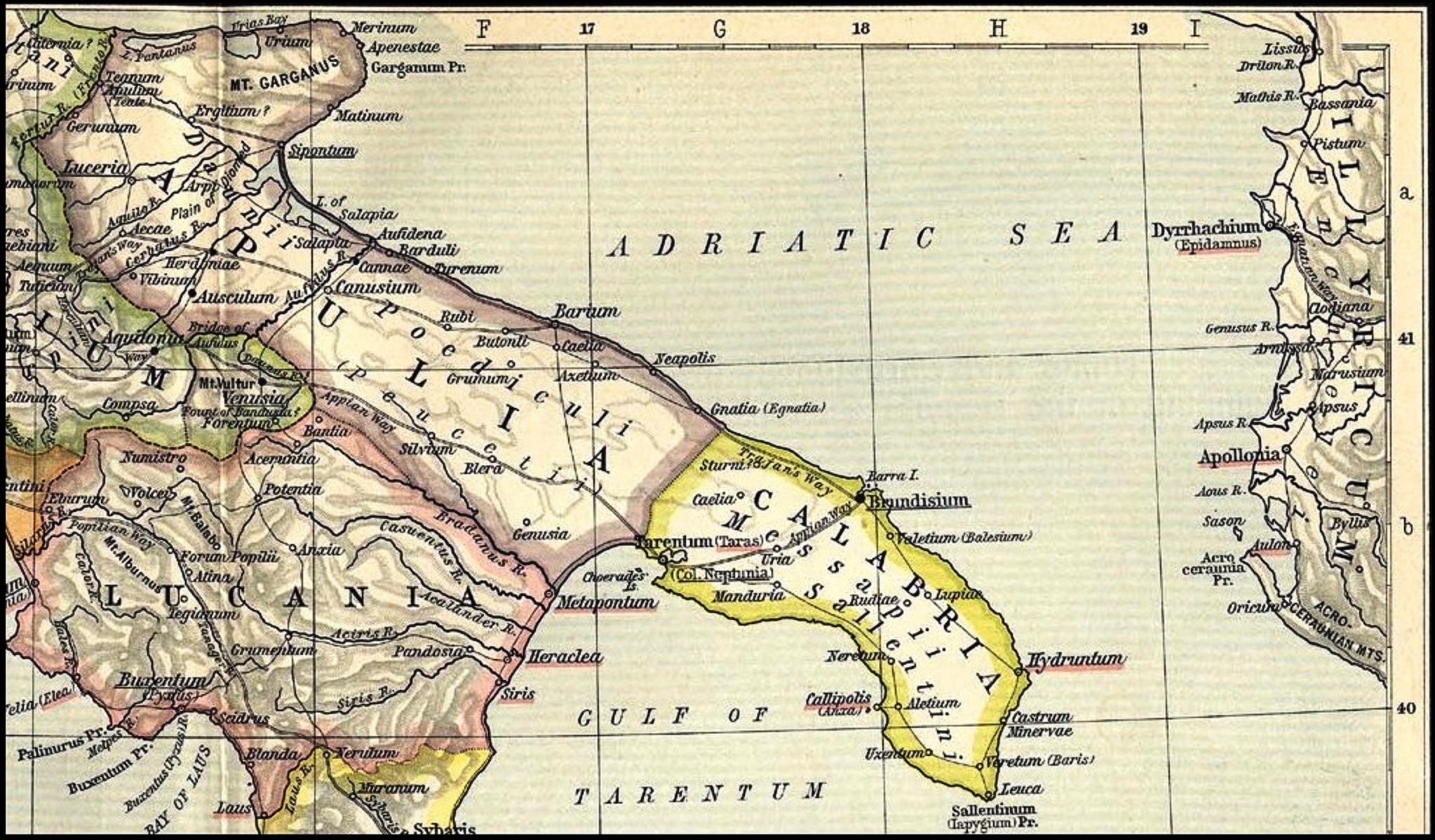|
Iapygian
The Iapygians or Apulians (; el, Ἰάπυγες, ''Ĭāpyges''; la, Iāpyges, Iapygii, Umbrian ''Iabuscer'') were an Indo-European-speaking people, dwelling in an eponymous region of the southeastern Italian Peninsula named Iapygia (modern Apulia) between the beginning of the first millennium BC and the first century BC. They were divided into three tribal groups: the Daunians, Peucetians and Messapians. After their lands were gradually colonized by the Romans from the late 4th century onward and eventually annexed to the Roman Republic by the early 1st century BC, Iapygians were fully Latinized and assimilated into Roman culture. Name The region was known to the Greeks of the 5th century BC as ''Iapygía'' (Ἰαπυγία), and its inhabitants as the ''Iápyges'' (Ἰάπυγες). It was probably the term used by the indigenous peoples to designate themselves. The name ''Iapyges'' has also been compared to that of the ''Iapydes'', an Illyrian tribe of northern Dalmatia. ... [...More Info...] [...Related Items...] OR: [Wikipedia] [Google] [Baidu] |
Messapic Language
Messapic (; also known as Messapian; or as Iapygian) is an extinct Indo-European languages, Indo-European language of the southeastern Italian Peninsula, once spoken in Apulia by the Iapyges, Iapygian peoples of the region: the ''Calabri'' and ''Salentini'' (known collectively as the Messapii), the Peucetians and the Daunians. Messapic was the pre-Roman Republic, Roman, non-Italic languages, Italic language of Apulia. It has been preserved in about 600 inscriptions written in an alphabet derived from a Archaic Greek alphabets, Western Greek model and dating from the mid-6th to at least the 2nd century BC, when it went extinct following the Roman Republic, Roman conquest of the region. Name The term 'Messapic' or 'Messapian' is traditionally used to refer to a group of languages spoken by the Iapygians, a "relatively homogeneous linguistic community" of non-Italic languages, Italic-speaking tribes (Messapii, Messapians, Peucetians and Daunians) dwelling in the region of Apulia bef ... [...More Info...] [...Related Items...] OR: [Wikipedia] [Google] [Baidu] |
Daunians
The Daunians ( el, Δαύνιοι, Daúnioi; la, Daunii) were an Iapygian tribe that inhabited northern Apulia in classical antiquity. Two other Iapygian tribes, the Peucetians and the Messapians, inhabited central and southern Apulia respectively. All three tribes spoke the Messapic language, but had developed separate archaeological cultures by the seventh century BC. The Daunians lived in the Daunia region, which extended from the Daunian Mountains river in the southeast to the Gargano peninsula in the northwest. This region is mostly coincident with the Province of Foggia and part of Province of Barletta-Andria-Trani today. Daunians and Oscans came into contact in northern Daunia and southern Samnite regions. Gradually, parts of northern Daunia became "Oscanized". Name The ethnonym is connected to the name of the wolf, plausibly the totemic animal of this nation. The cult of the wolf was widespread in ancient Italy and was related to the Arcadian mystery cult. ''Daunos'' m ... [...More Info...] [...Related Items...] OR: [Wikipedia] [Google] [Baidu] |
Messapians
The Messapians ( grc, Μεσσάπιοι, Messápioi; la, Messapii) were a Iapygian tribe who inhabited Salento in classical antiquity. Two other Iapygian tribes, the Peucetians and the Daunians, inhabited central and northern Apulia respectively. All three tribes spoke the Messapian language, but had developed separate archaeological cultures by the seventh century BC. The Messapians lived in the eponymous region Messapia, which extended from Leuca in the southeast to Kailia and Egnatia in the northwest, covering most of the Salento peninsula. This region includes the Province of Lecce and parts of the provinces of Brindisi and Taranto today. Starting in the third century BC, Greek and Roman writers distinguished the indigenous population of the Salento peninsula differently. According to Strabo, the names ''Iapygians'', ''Daunians'', ''Peucetians'' and ''Messapians'' were exclusively Greek and not used by the natives, who divided the Salento in two parts. The southern and I ... [...More Info...] [...Related Items...] OR: [Wikipedia] [Google] [Baidu] |
Apulia
it, Pugliese , population_note = , population_blank1_title = , population_blank1 = , demographics_type1 = , demographics1_footnotes = , demographics1_title1 = , demographics1_info1 = , demographics1_title2 = , demographics1_info2 = , demographics1_title3 = , demographics1_info3 = , timezone1 = CET , utc_offset1 = +01:00 , timezone1_DST = CEST , utc_offset1_DST = +02:00 , postal_code_type = , postal_code = , area_code_type = ISO 3166 code , area_code = IT-75 , blank_name_sec1 = GDP (nominal) , blank_info_sec1 = €76.6 billion (2018) , blank1_name_sec1 = GDP per capita , blank1_info_sec1 = €19,000 (2018) , blank2_name_sec1 = HDI (2018) , blank2_info_sec1 = 0.845 · 18th of 21 , blank_name_sec2 = NUTS Region , blank_info_sec2 = ... [...More Info...] [...Related Items...] OR: [Wikipedia] [Google] [Baidu] |
Peucetians
The Peucetians ( grc, Πευκέτιοι, Peukétioi; la, Peucetii; later also grc, Ποίδικλοι, Poidikloi, links=no; la, Poediculi, links=no) were an Iapygian tribe which inhabited western and central Apulia in classical antiquity. Two other Iapygian tribes, the Daunians and the Messapians, inhabited northern and southern Apulia respectively. All three tribes spoke the Messapian language, but had developed separate archaeological cultures by the seventh century BC; however, in Peucetian territory ancient Greek and Oscan language were spoken as well, as the legends of the currencies from Rubi and Azetium were trilingual. Peucetians lived in the eponymous region Peucetia, which was bordered by the Ofanto river and the Murge in the north, the Bradano river in the west and the territories of the Greek colony of Taras and the Messapians in the south. This region is mostly coincident with the Metropolitan City of Bari and parts of the provinces of Taranto and Barletta-Andr ... [...More Info...] [...Related Items...] OR: [Wikipedia] [Google] [Baidu] |



.jpg)
